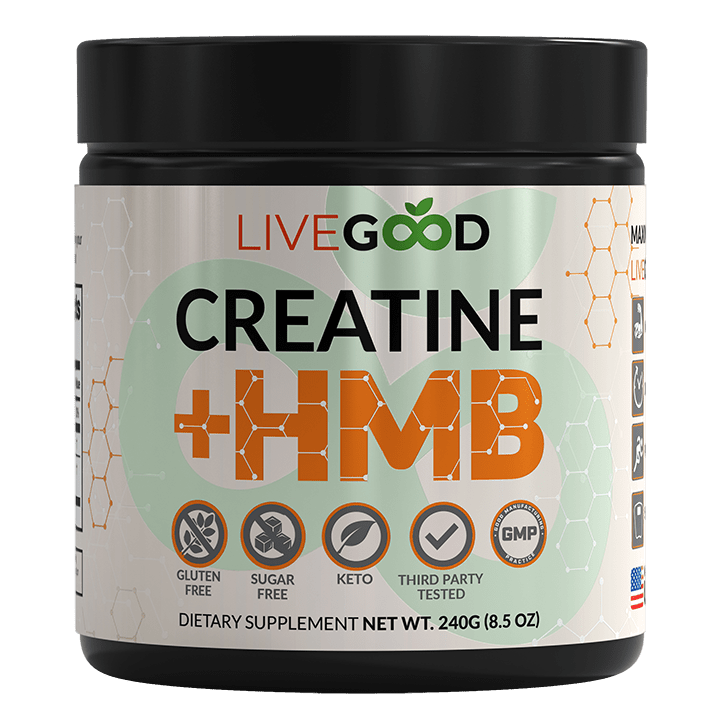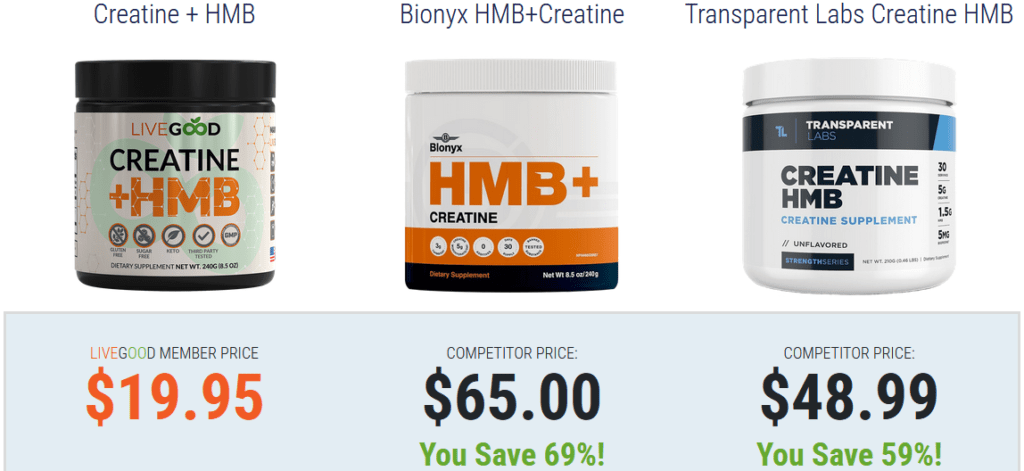LiveGood Creatine with HMB- A Complete Guide

The world of fitness and wellness can’t stop talking about LiveGood creatine with HMB. Creatine has proven itself to be effective and safe. It is also very well known. As far as supplements go, Creatine Monohydrate hands down is one of the most thoroughly researched and commonly used in the fitness community. In recent years, combining creatine with Beta-Hydroxy-Beta-Methylbutyrate (HMB) has gained a lot attention. It is claimed that this combination offers superior benefits. We will talk about those benefits here.
The historical past of creatine, the numerous ways in which it helps the human body, and any drawbacks it might have, have all undergone a good deal of research. In fact, the sheer amount of scientific findings on these aspects of creatine is astonishing. Creatine isn’t just a recent discovery of the 20th century. Its history stretches all the way back to the early 1800s. The scientific literature on the topics of creatine’s history, chemistry, and biochemistry is long and we’ll dig into it in this blog post.
The Discovery of Creatine
Discovered in 1832 by the French chemist Michel Eugène Chevreul, creatine is a natural compound in meat, which he named for the Greek term “kreas,” meaning meat. Chevreul’s discovery, though, was the first step on a long and winding road to understanding creatine’s potential, which really didn’t start to take shape until the early 20th century. That’s when scientists first began to understand how creatine works in muscles and the immense role it plays in energy production. In the 1970s, the concept of creatine supplementation started to generate excitement in the sports science community, which led to a boost in popularity during the 1990s.
Benefits of LiveGood Creatine
- Improves Exercise Performance:
- Improving performance during exercise is one of the primary reasons people take creatine. It does this by increasing the speed at which cells in the muscles can generate adenosine triphosphate (ATP). ATP is what the cells use to provide immediate energy for short bursts of intense effort. Creatine helps regenerate ATP which allows for sustained high-intensity performance. This is beneficial for activities like weightlifting, sprinting, and other explosive movements.
- Improves Glucose Intolerance:
- Current studies suggests that creatine supplementation may improve glucose tolerance and insulin sensitivity. Creatine helps increase the expression of glucose transporter type 4 (GLUT-4), which aids glucose uptake into cells. This process can be beneficial for individuals with type 2 diabetes or those at risk of developing the condition.
- Enhances Energy Production:
- As already noted, the renewal of ATP through phosphocreatine is a critically important part of high-intensity exercise. High-intensity exercise leads to fatigue; however, we know that increasing the stores of phosphocreatine can enhance the resynthesis of ATP, which in turn can be used to supply the needed energy in the muscle.
- LiveGood Creatine Improves Strength:
- Creatine is well-known for its ability to increase muscle strength. Studies have consistently shown that creatine supplementation leads to significant gains in muscle strength and power. This is largely due to its role in ATP production and the enhanced ability to perform high-intensity, short-duration exercises.
- Improves Workout Recovery:
- Another way LiveGood creatine can help during exercise is to reduce the amount of damage done to your muscles, and the ensuing inflammation and soreness that comes with it. Creatine helps your muscles recover by aiding in the resynthesis of adenosine triphosphate, or ATP, the energy molecule for your cells.
- Enhances Methylation:
- Methylation is an important biochemical process involved in gene expression, detoxification, and neurotransmitter production. Creatine synthesis uses a significant amount of S-adenosylmethionine (SAMe), a major methyl donor in the body. When you supplement with creatine, the body’s demand for SAMe decreases, which can enhance overall methylation processes and support various physiological functions.
- Improves Bone Healing:
- The research proves that creatine has positive implications for the healing and strength of bones because it increases the activity of the cells responsible for forming new bone, the osteoblasts. This makes LiveGood creatine a potentially valuable supplement for those recovering from fractures or dealing with osteoporosis.
- Improves Cognition:
- The usefulness of creatine isn’t limited to physical performance: it’s good for the brain too. A series of studies has shown that creatine supplementation improves memory, intelligence, and overall cognitive ability. Several researchers even think it may be the “most effective nootropic supplement,” a term that refers to substances that boost brain performance.
- Helps Fight Certain Neurological Diseases:
- Creatine has shown promise in the treatment and management of several neurological diseases. It helps by providing neuroprotective effects, enhancing mitochondrial function, and reducing oxidative stress in the brain. More research is needed but these findings are promising for the use of creatine in neurological health.

LiveGood Creatine with HMB is better than Creatine Alone
The synergy of supplements happens when you stack certain ones together and they produce an effect that is stronger than what they can do on their own. Two supplements that when stacked together augment this effect are creatine and HMB. HMB is short for beta-hydroxy-beta-methylbutyrate. It is a metabolite of the amino acid leucine and a compound that scientists have started using as a muscle-builder in its own right. Here’s why the combination is superior:
- Enhanced Muscle Mass and Strength:
- The strength and power of muscles are increased by creatine, while the muscles’ breakdown of protein is reduced by HMB. Taken together, these supplements help achieve the more significant effects of increased muscle mass and strength and are especially effective when taken in supplementation of resistance training.
- Improved Recovery and Reduced Muscle Damage:
- HMB is famous for being anti-catabolic, meaning it helps to prevent muscle damage and soreness after workouts. Muscle building occurs during the recovery process after a workout, and HMB has been shown to help with this. The glory days of HMB came a decade ago when studies on rats appeared to show that HMB actually doubled their muscle gains. When combined with creatine, a compound that regenerates energy stores in your muscles, abbreviated as ATP, and HMB’s anti-inflammatory properties, you’ve got a formula for speedier recovery.
- Increased Endurance and Performance:
- Endurance and total athletic performance increase when creatine and HMB are taken together. Creatine is responsible for giving ATP, the body’s main energy currency, an extra phosphate group so that it can function in the high-intensity realm of the body. HMB is responsible for maintaining muscle health and function during prolonged periods of endurance activities in the body. Endurance athletes, in particular, are likely to see the most benefit from taking both substances together.
- Synergistic Effects on Fat Loss:
- Studies have confirmed that when caloric intake is restricted, HMB helps combat muscle loss. Similar outcomes have been seen with creatine. This isn’t just good news for bodybuilders. A lot of us—particularly as we age—could also benefit. Even if that extra muscle means we just look better by the pool, the payoff is about more than appearance.

Potential Side Effects of Creatine
For most individuals, creatine is seen as relatively safe when taken in recommended amounts. But there can be side effects in rare cases, such as:
- Weight Gain:
- Because of more water being held in the muscles, certain users could put on pounds.
- Digestive Issues:
- Certain individuals may endure cramps, queasiness, or loose bowels, particularly if the serving size is sizable.
- Kidney Stress:
- While it is not very common, taking a lot of creatine for a long time might harm the kidneys. Very few cases of damage to the kidneys have been reported, and almost all of them involved high doses of the supplement for an extended period. Individuals with pre-existing kidney conditions should consult a healthcare provider before supplementing with creatine.
- Dehydration:
- Because creatine draws water into muscle cells, there is a risk of dehydration if adequate fluid intake is not maintained.
Conclusion
The benefits of LiveGood creatine supplementation are vast and well-documented. This is an incredibly effective and safe supplement that has been shown to increase strength, power, and exercise performance, not only in the short term but also with very few long-term negative effects. An abundance of research have all shown creatine to be safe when used as directed.
The benefits of using creatine alone are substantial, and when used in conjunction with HMB, they work together to provide a lot of superior bang for your buck. HMB by itself has some great benefits. But when you pair it with creatine, you amplify the effects of both substances. It’s nice to know that LiveGood creatine contains HMB for the added benefit.
Also check out LiveGood whey protein isolate.




One Comment